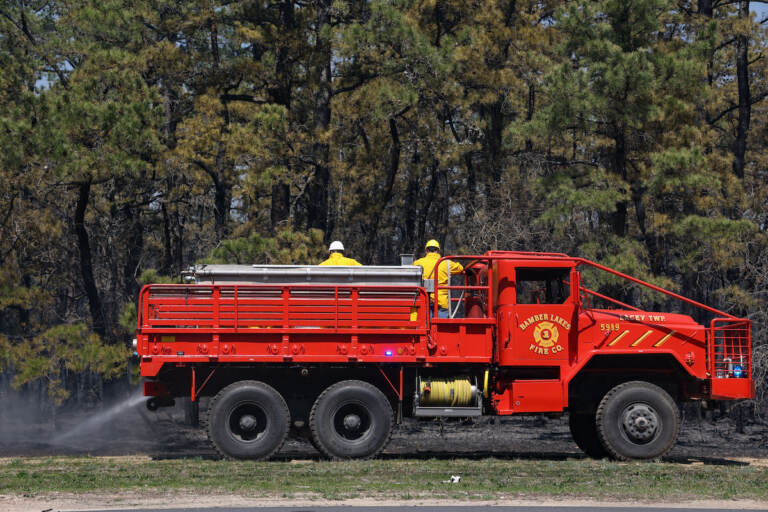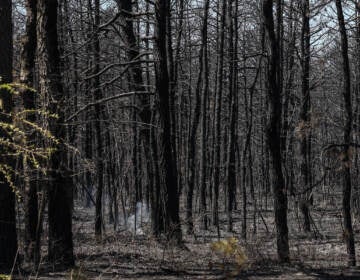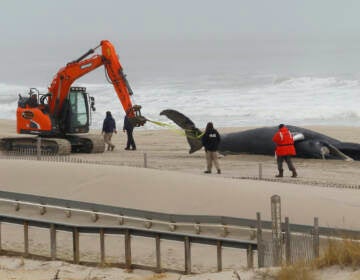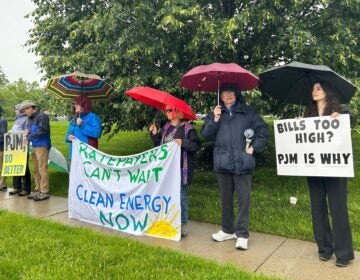Climate change is increasing wildfire risk in New Jersey, new report says
A new report looking at weather data over the last five decades has found an increase in fire weather days in the Garden State, and it could be devastating.

New Jersey firefighters work to put out hotspots in the Pine Barrens along Route 70 caused by the Jimmy’s Waterhole Fire on April 12, 2023. (Kimberly Paynter/WHYY)
This story is part of the WHYY News Climate Desk, bringing you news and solutions for our changing region.
From the Poconos to the Jersey Shore to the mouth of the Delaware Bay, what do you want to know about climate change? What would you like us to cover? Get in touch.
The increasing risk for wildfires is not just a problem for the western U.S.
“It’s all over the place,” said Kaitlyn Trudeau, a senior research associate at Climate Central who led the analysis of weather data for the past five decades and helped write the new report, “Wildfire Weather: Analyzing the 50-year shift across America.”
The research found that the number of fire weather days are increasing nationwide, including in the eastern half of the country and New Jersey. Fire weather days are when conditions are favored for a wildfire to spread.
Researchers looked at data from 476 weather stations in the lower 48 states to assess changes in the 50-year period between 1973-2022.
The data shows climate change is causing more hot, dry or windy days in most places. North Jersey and the coastal area of New York has added around 10 days of fire weather since 1973. South Jersey added around four days.
While the risk of wildfire is greater in North Jersey, South Jersey still sees, on average, two weeks of fire weather annually, according to Trudeau. State officials have said peak wildfire season has expanded into four- to five-month month period due to climate change.
In April, a wildfire tore through six acres in the Pine Barrens, causing residents to flee and take shelter at a high school.
Southeastern Pennsylvania picked up five additional fire weather days, while northern Delaware saw the number of fire weather days reduced by one. Five fire weather days were gained in Southern Delaware.
As the most densely populated state, more New Jersey residents are increasingly at risk of being in the path of a wildfire. Urbanization, along with increased development of forests and forest edges, has expanded the “wildland urban interface,” an area where development and unoccupied land mix.
“Generally speaking, we are seeing more people…moving towards these areas of risk, moving towards these areas that are getting hotter and drier and we’re seeing more development,” Trudeau said.
A wildfire is not limited to forests. It can spread to an office park or neighborhood. If the conditions are right, a blaze can burn longer and faster. It can also be much harder to put out.
“Whether that fire burns out-of-control or not will depend on several things,” Trudeau said. “But one of the important things is the weather.”
The report focused on three weather conditions essential to fire weather: relative humidity, temperature and wind.
When relative humidity levels are very low, the air feels dry and draws moisture from the land, leaving vegetation dehydrated. Hotter temperatures affect humidity and dryness. It also affects fire behavior. Wind not only supplies oxygen to a fire, it also increases evaporation and helps to dry out the land.
Trudeau said educating yourself and being prepared for fire weather days is the best thing to do.
“Figure out where you live, what the environment is like,” she said, warning it’s getting easier for more dangerous fires. “Be mindful of what you’re doing if you go camping…barbecuing [or] hiking.”
Trudeau also suggests doing your part to combat climate change by reducing your individual greenhouse gas emissions.
“People hate that answer,” she said. “But there’s just no other way to really reduce the impact the climate is having on these things.”

Get daily updates from WHYY News!
WHYY is your source for fact-based, in-depth journalism and information. As a nonprofit organization, we rely on financial support from readers like you. Please give today.







